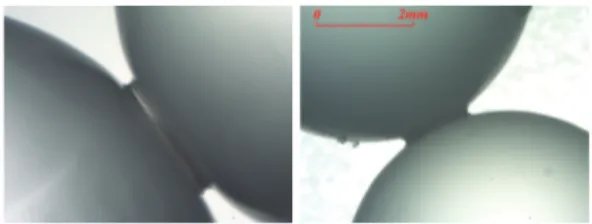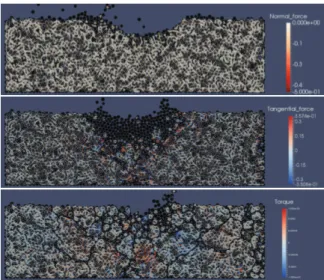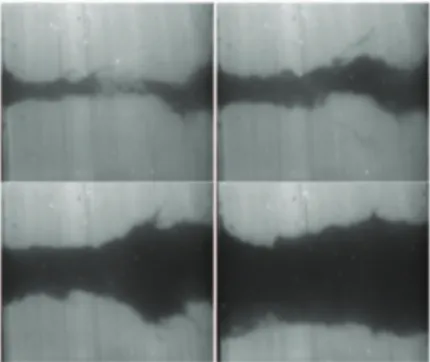HAL Id: hal-01582949
https://hal.archives-ouvertes.fr/hal-01582949
Submitted on 6 Sep 2017
HAL is a multi-disciplinary open access
archive for the deposit and dissemination of
sci-entific research documents, whether they are
pub-lished or not. The documents may come from
teaching and research institutions in France or
abroad, or from public or private research centers.
L’archive ouverte pluridisciplinaire HAL, est
destinée au dépôt et à la diffusion de documents
scientifiques de niveau recherche, publiés ou non,
émanant des établissements d’enseignement et de
recherche français ou étrangers, des laboratoires
publics ou privés.
Distributed under a Creative Commons Attribution - ShareAlike| 4.0 International
License
P. Philippe, P. Cuéllar, F. Brunier-Coulin, L.H. Luu, N. Benahmed, et al.. Physics of soil erosion at the
microscale. 8th International Conference on Micromechanics of Granular Media (Powders and Grains
2017), Jul 2017, Montpellier, France. pp.08014, �10.1051/epjconf/201714008014�. �hal-01582949�
Physics of soil erosion at the microscale
Pierre Philippe1, ⋆
, Pablo Cuéllar1,2, Florian Brunier-Coulin1, Li-Hua Luu1, Nadia Benahmed1, Stéphane Bonelli1, and Jean-Yves Delenne3
1IRSTEA, UR RECOVER, 3275 route de Cézanne, 13182 Aix-en-Provence, France. 2BAM, Division 7.2 Buildings and Structures, Unter den Eichen 87, 12205 Berlin, Germany. 3UMR IATE, INRA/CIRAD/Montpellier SupAgro, 2 place Pierre Viala, 34060 Montpellier, France.
Abstract. We focus here on the major and still relevant issue of soil erosion by fluid flows, and more specifically on the determination of both a critical threshold for erosion occurrence and a kinetics that specifies the rate of eroded matter entrainment. A state-of-the-art is first proposed with a critical view on the most commonly used methods and erosion models. It is then discussed an alternative strategy, promoting the use of model materials that allow systematic parametric investigations with the purpose of identifying more precisely the local mecha-nisms responsible for soil particle erosion and ultimately quantifying both critical onsets and kinetics, possibly through existing or novel empirical erosion laws. Finally, we present and discuss several examples following this methodology, implemented either by means of experiments or numerical simulations, and coupling erosion tests in several particular hydrodynamical configurations with wisely selected mechanical tests.
1 Introduction
Erosion and transport of cohesive soil sediments by fluid flows are of primary concern in many processes, either in natural or manmade environments, as fluvial morpholog-ical changes, spreading of pollutant or radionucleides in river sediments, impact of agricultural soil erosion on the global carbon cycle, local scour at bridge piers, external and internal erosion of earthen hydraulic structures [1].
The present contribution focuses on two related funda-mental issues: (i) How to properly predict a critical con-dition, if any, for occurrence of erosion? (ii) How to ac-curately quantify the amount of eroded soil particles? It is first presented here a brief synthesis of the most usual methods used to tackle these issues with particular atten-tion to what are the major remaining problems or contra-dictions which could limit the general scope, or even the validity, of these previous approaches. As a consequence, an alternative methodology is proposed, based on system-atic investigations, either experimental or by means of nu-merical models, with artificial cohesive materials and aims to combine erosion tests in some specific fluid flow con-figurations with better targeted, or even specially devel-oped, mechanical characterisations of our model systems. As illustrated by several preliminary tests following the previous strategy, a specific scope is put on the local pro-cesses of matter entrainment by a fluid flow inducing what is more globally called soil’s erosion at a more wider scale, both in space and time.
⋆e-mail: pierre.philippe@irstea.fr
2 Quantification of soil erosion and
related issues
Being able to quantify erosion of a soil by a neighbor-ing fluid flow requires first to select both space and time scales over which the amount of eroded matter and the hydrodynamical load exerted by the fluid flow should be considered and quantified. Owing to the large variety of practical issues, the space scale can span from kilome-ter squares to microns, including for instance wakilome-tersheds, riverbanks, soil specimens in the lab, or only few sedi-ment layers, while the duration under consideration can go from seconds to months, or even more in some geo-logical phenomena. This first choice prescribes the type of erosion models needed to achieve a consistent predic-tion, in particular regarding the quantities that can be used to account for the action of the eroding fluid flow. In a soil mechanics perspective as will be considered in the fol-lowing, the size of a soil sample under study is typically equal to some centimeters, or tens of centimeters, and the rates of erosion are estimated over time periods of seconds to minutes. Regarding the flow regime which is turbulent in most applications, an hydrodynamical indicator, able to account for the hydrodynamic force exerted by the flow on the soil surface, is not easy to quantify since the fluid flow highly fluctuates in time and also, most often, in space. The simplest and most commonly followed solution con-sists in a crude averaging of the chosen quantity. Alter-native approaches can be developed, mostly based on sta-tistical modeling, but might be hard to apply successfully in practice since a realistic probability density function is needed. The same uncertainty about the use of average
on fluvial sediment transport, the resistance to erosion can be expressed through a critical dimensionless shear-stress whose value can be approximated from simplified mech-anistic models describing the equilibrium of a single par-ticle and accounting for drag force, buoyant weight and friction. The more usual situation of a cohesive soil is far much complicated and knowledge is lacking on local processes of erosion at a natural soil surface to consider developing similar mechanistic models.
In practice, the very large majority of previous and ac-tual studies seeking to assess the sensitivity of natural soils to fluid flow erosion have based their analysis assuming the following expression of a local erosion law that ac-counts for a threshold and relates ˙m, the rate of mass re-moval by units of time and surface, to τ, the shear-stress exerted by the fluid flow at the soil’s surface [2, 4]:
˙
m = ker(τ − τc) if τ > τc, (1)
˙
m =0 otherwise. (2) In this purely empirical modeling, τc(in Pa) is a critical
shear-stress and ker (in s.m −1
) is a kinetic erosion coeffi-cient. Both parameters are sometimes called soil’s erodi-bility. Several erosion tests have been developed to pro-vide direct measurements or (sometimes crude) estimates of eroded mass and hydrodynamical shear-stress. Based on the local erosion law in Eq. 1 (or a slightly modi-fied version), a fitting procedure ultimately provides the erodibility parameters. Correlations between those pa-rameters and more common soil’s properties are still be-ing explored. If rather accurate trends are observed for a same soil, very different and hardly predictable values of erodibility can be found from one soil to another and also possibly from one erosion device to another. The latter result raises in particular questions regarding the postu-lated intrinsic nature of erodibility. The many different, and sometimes contradictory, empirical relationships pro-posed in the literature are far from providing a definitive answer. Another general issue concerns the use of aver-age quantities, especially when describing the fluid flow, which appears in serious contradiction with a process as erosion which assumes the existence of an inherent soil’s threshold. Indeed, the local hydrodynamic stress values are naturally distributed (fluctuations, turbulence) and the highest portion of this distribution might exceed the soil’s critical threshold τcwhile the average stress remains
be-low it, generating intermittent particle extraction and con-sequently sustaining over time a non-zero rate of erosion.
3 Methodology
Regarding the related literature, very little is known about the real processes at work at particle scale and
Figure 1. (Left) Capillary bridge of Ucon Oil between 3mm glass beads. (Right) Solid bridge of paraffin between 7mm glass beads after solidification of the original capillary bridge of liquid paraf-fin.
which commonly hide behind the general term of ero-sion. Furthermore, as discussed previously, no clear pic-ture has emerged from the most popular route based on direct empirical correlations between resistance to ero-sion and many different usual material properties obtained for a large variety of natural soils. This approach pos-sibly reaches its limits, facing a rather complex phe-nomenon and the present contribution proposes to reverse the methodology by using purely artificial materials which can advantageously allow for both a much more accurate control of some key properties (as cohesion, particle size, etc) and, whenever possible, for a direct visualization of the basic local processes of solid matter removal by a fluid flow. Our goal is first to gain insights from the fundamen-tal scale in order to reach a better understanding of the mi-crostructural scenarios of soil’s erosion. Second, to iden-tify and rationalize these local mechanisms would con-stitute an important step towards clearer relationships be-tween some pertinent usual properties of a material, whose characterization might requires the development of spe-cific mechanical tests, and some more application-oriented empirical characterizations as the previous erodibility pa-rameters ker and τc, or possibly some new ones related
to alternative local erosion laws to be proposed. Such a breakthrough could considerably supplement the usual ap-proach for erosion risk assessment and accordingly moti-vates this work.
3.1 Model materials
For the present contribution, three different types of co-hesive soils have been considered. The first type of ma-terials that can be rather simply prepared and studied is made of large granular particles with adhesive bonds at inter-particle contacts. Such contact bonds can be either liquid or solid as illustrated in Figure 1. It is to be noticed the main differences between liquid and solid bonds: solid bridges are usually far much resistant than liquid ones but the latter can be broken and then created back with strong hysteresis while the rupture of a solid bond is permanent and irreversible. Regarding the grains, they can come from either a natural sandy material or an artificial one as the previous glass beads in Fig. 1 which can advantageously enable the additional implementation of two coupled op-tical techniques, Refractive Index Matching and Planar Laser Induced Fluorescence, to access to a direct
visual-Figure 2. Typical sequence (from left to right and top to bottom) of scour erosion of a magic sand during a 2D water jet test. The arrow indicates the location of the impinging water jet.
ization of the local erosion process provided that the erod-ing fluid is an index-matched mixture [5]. The behaviour of such a cohesive granular material with solid bonds can also be investigated by means of the coupling between the Discrete Element Method (DEM) and the Lattice Boltz-mann Method (LBM), which is certainly today one of the numerical methods being the most increasingly used for the modeling of fluid-grain systems. An attractive bond at each grain contact is implemented thanks to an additional cohesion model between the solid particles which is based on a relatively straightforward rheology (i.e. viscoelastic-perfectly-plastic) and on the de-bonding limit (yield) con-ditions introduced by Delenne and coworkers [3] which permit the consideration of bond ruptures in tension, shear and bending conditions.
The second type of model cohesive soils that can be easily studied through systematic investigations are chemically-treated sands, as magic sand and kinetic sand. The first one is a building toy made of hydrophobic sand grains and can consequently be viewed as a granular ma-terial with an effective "skin" cohesion arising from the Laplace over-pressure at the interface between air and water. Kinetic sand , made of 98% sand and 2% poly-dimethylsiloxane (a type of silicone oil), is another toy ma-terial specially developed to mimic the physical behaviour of wet sand with reversible adhesion between grains.
The third kind of artificial cohesive soils corresponds to homogeneous materials, modeled in a continuous medium perspective and able to mimic loamy soils made of very small particles with strong attractive interactions. A synthetic clay as Laponite appears as a sound choice since its yield-stress rheology can be systematically varied and because it also has the great advantage to be transpar-ent and thus to allow here again for direct visualization of solid matter retrieval during an erosion test.
3.2 Coupling hydrodynamic and mechanical tests
As an integral part of our methodology, erosion and me-chanical tests must be implemented in parallel. The choice of the hydrodynamical configuration inducing erosion de-termines the ability to measure and/or model accurately some key quantities as shear-stress or velocity and to reach sufficient intensity level for erosion to occur. In the present paper, some already existing configurations, as jet erosion
Figure 3. Jet erosion tests on a soil where the cohesion model at particle contacts presents a small yield value under tension (top), under shear (middle), and under bending (bottom), respectively.
Figure 4. Linear correlations between the erodibility parameters τc(black squares) and ker(blue circles) of a kinetic sand, deduced
from the classical interpretation model with a 2D pressurised-air jet test (differential pressure ∆P = 200Pa), and the undrained cohesion Cu, obtained from a fall-cone test.
test and hole erosion test, were used but sometimes with specific adaptations (fluid, geometry, optical techniques) enabling direct visualization of the local process. By way of example, Figure 2 shows a jet erosion test on a magic sand where the geometry was restricted to 2D for obser-vation purpose. Some rather usual mechanical tests were carried out with our artificial materials, as fall-cone test, while several other ones were specifically developed for instance to measure tensile strength both at contact and sample scales [7].
4 Some preliminary results
Quite an extensive study of our first model material (i.e. glass beads bonded by solid bridges), subjected to erosion by impinging of an immersed jet, has already been carried out by part of the present authors and will be presented elsewhere [7]. However, several recent and original re-sults can be presented, even if they are still preliminary
Figure 5. Time evolution of an initially cylindrical pipe in a transparent synthetic clay sample during a Hole Erosion Test with water flow from left to right. The flow rate is progressively increased and the pictures correspond (from left to right and top to bottom) to successive times t = 94s, t = 200s, t = 350s, and t =800s. The dimension of the pictures is 70mm × 58mm.
Figure 6. Close-up from the previous test (Fig. 5) where a crack propagation is clearly identified above the pipe and induces the final pull-out of a large aggregate.
at this stage. To start with, our first type of model ma-terial has also been studied in a jet erosion configuration but this time by means of a numerical DEM-LBM mod-eling as previously mentioned. More precisely, the influ-ence of the cohesion model at particle contacts was tested through deliberately exaggerated soil’s behaviours by im-posing a very weak value of the solid bond yield alterna-tively under tension, shear and bending loading. As can be seen on Figure 3, widely different erosion processes are observed in the three distinct cases: (i) almost usual grain-by-grain erosion, (ii) remote debonding to a rather long extent within the sample, (iii) in-depth fracturing creating large aggregates.
Another example deals with the same kind of jet ero-sion test but performed this time on one of our second model materials, namely kinetic sand, and with pres-surised air as eroding fluid. Changing the initial density of the kinetic sand allows to control quite accurately the undrained cohesion Cu estimated via a cone-fall test (by calibration from penetration depth of a falling cone, re-leased from a given height, within a soil’s specimen). Dur-ing a jet test, a classical fittDur-ing procedure of the scour crater depth versus time using Eq. 1 provides the erodibility pa-rameters τcand ker which, as underlined in Figure 4, are
nicely and almost linearly correlated to Cu.
stress. Figure 5 gives a general overview of the pipe en-largement versus time while Figure 6 is a close-up where crack initiation and propagation can be observed till a large aggregate is ultimately washed away.
5 Conclusion
The starting point of the present contribution was the iden-tified limitations and remaining issues regarding theoret-ical and experimental state-of-the-art in quantifying ero-sion of natural soils. It was then proposed to reverse the classical methodology, substituting real soils by artificial materials, in both experimental and numerical perspec-tives, with the purpose to better control key properties of the materials so as to implement systematic analysis of sensitivity to erosion, including whenever possible direct visualization of the basic local processes of solid matter removal by a fluid flow as well as specifically selected, or developed, mechanical tests. Several examples of such model materials were first described before some encour-aging preliminary results were presented and discussed. Much more work is now required to achieve comprehen-sive results continuing this strategy.
Acknowledgements
The authors acknowledge a financial support from the re-gion PACA (France) through the APEX-ESCAPE project.
References
[1] S. Bonelli (Ed.). Erosion in Geomechanics Applied to Dams and Levees. Wiley-ISTE (2013)
[2] E. Partheniades. J. Hydr. Div. ASCE 91(HY1) 105-139 (1965)
[3] Y. Delenne, M.S. El Youssouffi, F. Cherblanc, J.-C. Bénet. Int. J. Num. Anal. Meth. Geomech. 28 1577-1594 (2004)
[4] A. Knapen, J. Poesen, G. Govers, G. Gyssels, J. Nachtergael. Earth-Sciences Reviews 80(1-2) 75-109 (2007)
[5] P. Philippe, M. Badiane, Phys. Rev. E. 87(4) 042206 (2013)
[6] P. Cuéllar, P. Philippe, S. Bonelli, N. Benahmed, F. Brunier-Coulin, J. Ngoma, J.-Y. Delenne, F. Radjaï. Proceedings of the 4th International Conference on Particle-based Methods – Fundamentals and Applica-tions, PARTICLES 2015. E. Oñate, M. Bischoff, D.R.J. Owen, P. Wriggers & T. Zohdi (Eds).
[7] F. Brunier-Coulin, J.-L. Sarrat, P. Cuéllar, P. Philippe. (Accepted for P&G2017).


